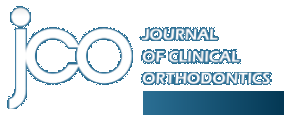Search Results For: 'management & marketing'
961.
OVERVIEW
Volume 52 : Number 0 : Page 325 : Jun 2018
Drs. Veeranki, Park, Pruzansky, Takagi, and Tai present up-to-date information pertinent to the identification and quantification of facial asymmetry. Etiological factors, pathogenesis, diagnostic methods, treatment planning, and surgical options are all illustrated with tables and clinical examples.
962.
Orthodontic Study Groups, Cleveland Study Group II
Volume 2 : Number 9 : Page 0 : Nov 1968
A small orthodontic study group can be advantageous. It provides a means of obtaining and exchanging information to improve one's practice. With a death and disability contract, it can serve as excell...
963.
Volume 9 : Number 11 : Page 713 : Nov 1975
Experience with the computerized timing headgear in the treatment of over two hundred cases in my office has produced some interesting new information about its use and its impact on an orthodontic pr...
964.
Word Processing: A Step Toward Painless Dental Communications
Volume 10 : Number 6 : Page 446 : Jun 1976
Dr. C.E. Kavanaugh is an orthodontist in Kansas City, and while his practice is specialized, many of its inherent problems are not. One particular problem is the need to constantly and consistently co...
965.
Third Party Interference in Orthodontic Practice
Volume 10 : Number 10 : Page 770 : Oct 1976
Mr. Martin L. Schulman Chairman of the BoardDental Corporation of America P.O. Box 1011 Washington, D.C. 20013Dear Bud,During the past year to year and one-half, a situation with insurance carriers ha...
966.
Team Development in Orthodontics: Role Relationship Clarification
Volume 11 : Number 11 : Page 764 : Nov 1977
The delivery of excellence in an orthodontic practice requires that the doctor and staff continuously work and study to provide superior technical and administrative skills, which requires a degree of...
967.
Orthodontic Economic Index--1983
Volume 17 : Number 7 : Page 483 : Jul 1983
The orthodontic economic index presented here was derived from an analysis of more than 200 orthodontic practices established for five years or longer. No new practices were included, and high and low...
968.
The Bonded Lingual Retainer and Multiple Spacing of Anterior Teeth
Volume 17 : Number 12 : Page 838 : Dec 1983
In 1977, promising short-term clinical experience (1 to 2.5 years) with 43 bonded lingual canine-to-canine retainers was reported.11 These retainers were made of .032" to .036" wire with loops at the ...
969.
Volume 18 : Number 9 : Page 642 : Sep 1984
The effectiveness of an orthodontic practice--including the well-being of the orthodontist and staff and the patients' attitudes toward the office--depends upon proper scheduling of patients. Unfortun...
970.
Severe Ocular Injuries from Orthodontic Headgear
Volume 19 : Number 11 : Page 819 : Nov 1985
Extraoral traction devices are commonly used orthodontic appliances. Commonly referred to as headgear, these devices are used to reposition teeth during orthodontic therapy. They frequently consist of...
971.
Volume 20 : Number 3 : Page 0 : Mar 1986
Choosing an office location--whether for a new graduate or for an established orthodontist seeking a satellite or new site--can be complicated and time-consuming. This article outlines potential sourc...
972.
Clinical Implications of Advances in Orthognathic Surgery
Volume 23 : Number 6 : Page 0 : Jun 1989
Considerable recent progress has been made in the refinement of diagnostic and treatment-planning procedures for surgical-orthodontic treatment.1-7 Advances in four major areas have revolutionized ort...
973.
Clinical Use of Silicone Elastomer Appliances
Volume 23 : Number 10 : Page 0 : Oct 1989
Kesling introduced the tooth positioner for artistic finishing in 1945,1 and proposed a series of positioners for graduated movement toward a corrected occlusion in 1946.2 Because these positioners we...
974.
Volume 23 : Number 11 : Page 0 : Nov 1989
The Bass removable orthopedic appliance system1-4 (Fig. 1) can be used in growing patients with skeletal Class II malocclusions to optimize facial appearance and to rapidly and effectively correct the...
975.
Computerized Scheduling: Pros and Cons
Volume 24 : Number 1 : Page 0 : Jan 1990
Several of the companies producing orthodontic management software today offer computerized scheduling modules. With these programs, it is no longer necessary to maintain a paper appointment book. The...
976.
Volume 26 : Number 6 : Page 0 : Jun 1992
This month's topics are positioner appliances and employee embezzlement.1. In what percentage of your cases do you use a positioner appliance?Although 77% of the respondents said they used positioners...
977.
Volume 27 : Number 6 : Page 0 : Jun 1993
Topics include slot sizes, full vs. segmented arches, and use of loops; and inventory methods. 1. What slot size do you typically use? Fifty-seven percent of the clinicians reported using an .018"X.02...
978.
Volume 27 : Number 9 : Page 0 : Sep 1993
Topics include TMJ and practice newsletters.1. What percentage of your orthodontic patients would you estimate show TMJ signs or symptoms before treatment? during treatment? after treatment? Responses...
979.
When Will You Be Ready To Retire?
Volume 32 : Number 2 : Page 91 : Feb 1998
The following article is reprinted by permission from The Blair/McGill Advisory, a monthly dental practice management and financial newsletter published by Blair, McGill & Company, 4601 Charlotte ...
980.
A New and Improved Indirect Bonding Technique
Volume 33 : Number 1 : Page 17 : Jan 1999
Most orthodontists will agree that brackets can be positioned more accurately on study casts than directly on teeth in the mouth. Yet as recently as 1996, fewer than 10% of orthodontists routinely use...
Showing 961-980 of 1158 results. Search completed in 0.213 seconds.

